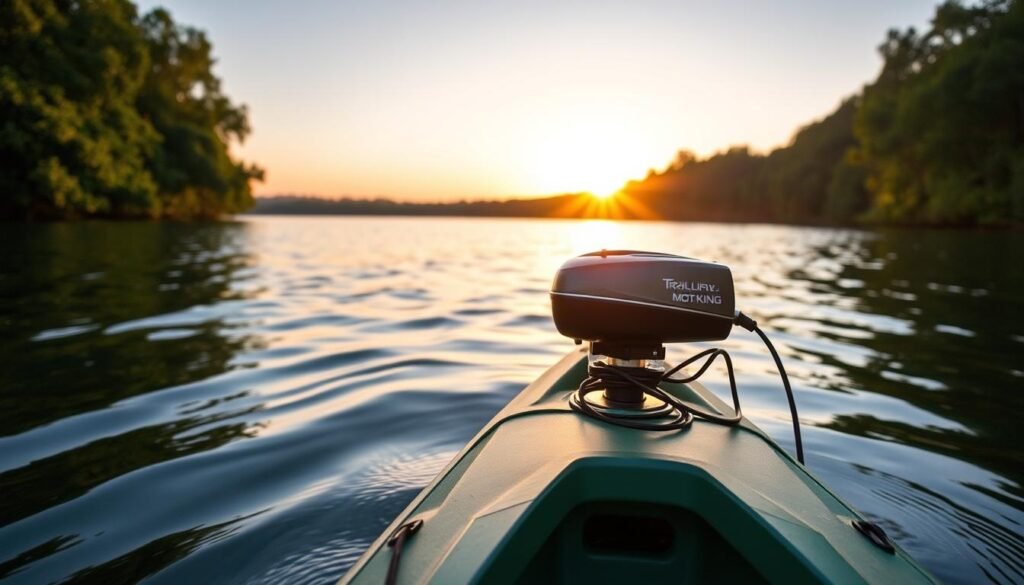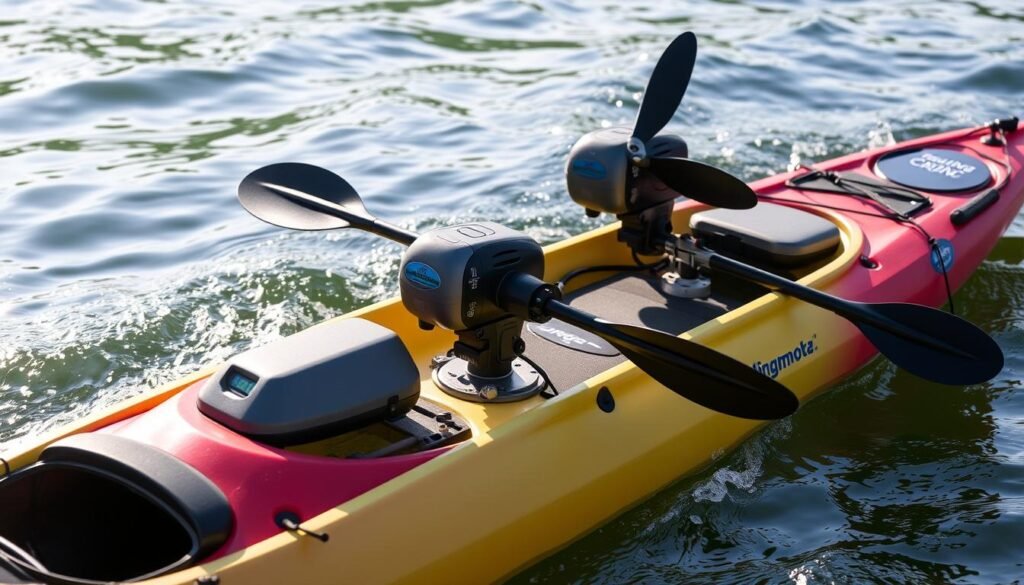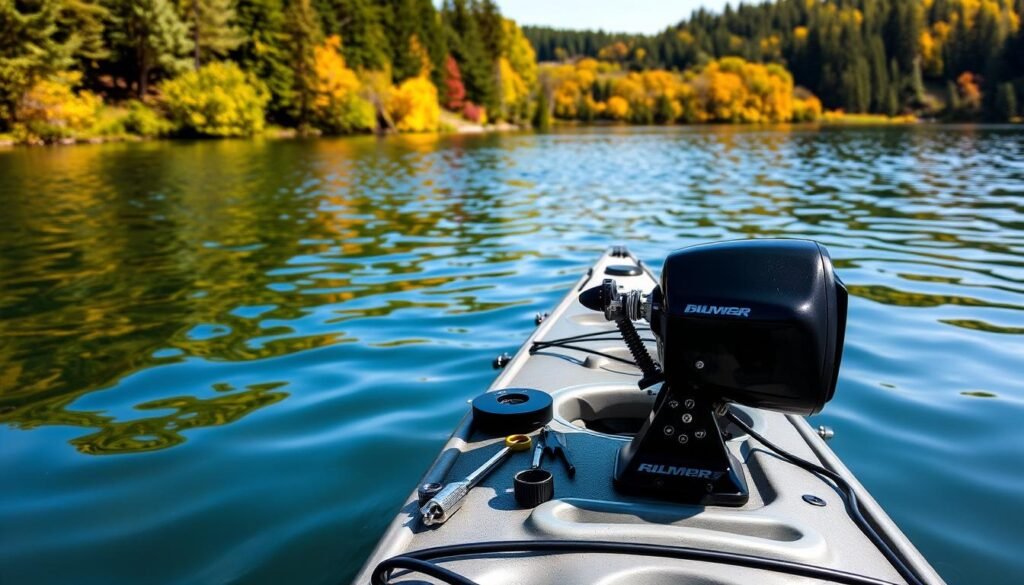Did you know the Torqeedo Ultralight 1103 AC can take your kayak up to 31 miles on one charge? This shows how far kayak trolling motor tech has come. Now, there are many powerful motors for kayaks, opening up new fishing possibilities.
Kayak trolling motors have turned simple boats into powerful tools for fishing. They let anglers move fast, cover more ground, and even sneak up on fish. This is because these motors are quiet and can be raised when needed.

We’ve looked at many trolling motors for kayaks. From the affordable Minn Kota Endura to the high-end MotorGuide Xi3 Freshwater series, there’s something for everyone. Each motor meets different needs and preferences.
Let’s explore the best trolling motors for kayaks together. We’ll look at the top picks for 2024. This will help you find the perfect motor for your fishing trips.
Understanding Kayak Trolling Motors Basics
Kayak trolling motors are a big help for anglers and paddlers. We’ve looked into how they work to make your time on the water better.
Types of Trolling Motors for Kayaks
There are many types of trolling motors for kayaks. Bow-mount motors give you control, while transom-mounts are simple to put on. Integrated motors blend right into your kayak. Lightweight motors are popular for being easy to carry.
Power and Thrust Requirements
The power needed depends on your kayak’s size and what you use it for. A common rule is 2 pounds of thrust for every 100 pounds of kayak. Most kayaks need 30 to 40 pounds of thrust, moving at 4 to 5 mph in calm water. Saltwater kayaks might need more power to fight currents.
Battery Options and Power Systems
Trolling motors usually run on 12V deep-cycle marine batteries. Lead-acid batteries are cheap but heavy. Lithium-ion batteries are lighter and last longer. Most kayaks use a 12V system, but bigger ones might need 24V or 36V for more power.
| Battery Type | Weight | Run Time | Cost |
|---|---|---|---|
| Lead-Acid | Heavier | Shorter | Lower |
| Lithium-Ion | Lighter | Longer | Higher |
The right trolling motor can change your kayaking for the better. It’s great for fishing in lakes or exploring the coast.
Best Trolling Motors for Kayaks in 2024
We’ve looked into the top trolling motors for kayaks to find the best for you. Our reviews cover a wide range, from affordable to high-end options.
MotorGuide Xi3 Freshwater Kayak Series
The MotorGuide Xi3 is the top pick for kayaks. It gets a 9/10 rating, with 55 pounds of thrust and a 36-inch shaft. It’s made for freshwater use and is very quiet.
Newport NK300 High-Performance Motor
The Newport Vessels Kayak Series is great for saltwater. It scores an 8/10, with a 24-inch shaft and 36 or 55 pounds of thrust. It also has a tiller handle for better control.

Torqeedo Ultralight 1103 Premium Option
The Torqeedo Ultralight 1103 is a top choice for those who want the best. It can go over 6.5 MPH and has built-in kayak steering. It’s expensive, but perfect for serious kayakers.
Bixpy K-1 Angler Pro Compact Solution
The Bixpy K-1 Angler Pro is a compact option for kayak anglers. It’s light and easy to carry, making it great for those who need something portable but powerful.
Minn Kota Endura Budget-Friendly Choice
The Watersnake T18 ASP is a good choice for those on a budget. It’s rated 7/10, with 18 or 24 pounds of thrust and a 24-inch shaft. It’s reliable for casual kayakers.
| Motor | Rating | Thrust | Best For |
|---|---|---|---|
| MotorGuide Xi3 | 9/10 | 55 lbs | Freshwater |
| Newport Vessels | 8/10 | 36-55 lbs | Saltwater |
| Watersnake T18 ASP | 7/10 | 18-24 lbs | Budget |
Key Features to Consider When Choosing a Kayak Motor
Choosing the right trolling motor for your kayak involves several important factors. We’ll look at these key features to guide you in making a smart choice. This will be based on kayak trolling motor reviews and your specific needs.
Shaft Length and Mount Type
The shaft length of your trolling motor should match your kayak’s size. For low-sitting kayaks, shorter shafts are best. A 24-inch adjustable shaft is often ideal, keeping the propeller submerged. Mount types include transom, bow, and side mounts. The 4-bolt mount is popular in the fishing kayak market.
Control Systems and Navigation
Control options range from hand-operated tillers to wireless remotes. Foot pedals are common for larger boats but not practical for kayaks. Some high-end models offer GPS-enabled systems for precise navigation.
Saltwater vs Freshwater Compatibility
Choose between saltwater trolling motors for kayaks and freshwater options based on your fishing environment. Saltwater motors, like the Watersnake T18 ASP, are designed to withstand corrosive conditions. Freshwater motors, such as the Minn Kota Freshwater Trolling Motor, offer great performance in lakes and rivers.
Weight and Portability Factors
For kayaks, lightweight motors are crucial. The Watersnake T18 ASP weighs just 4.85 lbs, making it easy to transport. Consider the total weight of your setup, including the battery, to ensure your kayak remains stable and maneuverable.
| Motor Model | Thrust | Weight | Compatibility |
|---|---|---|---|
| Newport Vessels NK 180 | 60 lbs | 23 lbs | Saltwater/Freshwater |
| Watersnake T18 ASP | 18 lbs | 4.85 lbs | Saltwater |
| AQUOS Haswing | 55 lbs | 19 lbs | Freshwater |
Installation and Maintenance Tips
Installing a kayak trolling motor can really improve your fishing trips. Always read the instructions from the manufacturer first. You might need extra tools, depending on your kayak’s type.
Make sure the motor shaft fits right. The propeller should be 12 inches under the water. Kayaks usually need 24 or 30-inch shafts because they’re close to the water. Choose where to mount it wisely. Bow-mounted motors give you more control, while stern-mounted ones are better for straight paths.

Keeping your trolling motor in good shape is vital. If you fish in saltwater, clean it with fresh water after each use to avoid rust. Always check the propeller for dirt and clean it when needed. Also, inspect the electrical connections for any damage or wear.
Don’t forget about your battery. You’ll need a deep cycle battery for your trolling motor. The battery’s amperage rating determines how long it will run. For all-day fishing, a 12-volt 100-amp-hour lithium battery is a good choice. Remember, using higher speeds will use more power, so plan your fishing trip accordingly.
By following these tips, your kayak trolling motor will stay in great condition. This will give you many happy hours on the water. Regular care not only makes your gear last longer but also makes your kayaking trips better.
Conclusion
We’ve looked at the top trolling motors for kayaks, showing how fishing tech has grown. From the Minn Kota Endura C2 30 for those on a budget to the Newport Vessels NV-Series for high performance, there’s something for everyone.
The Minn Kota Endura C2 30 costs $154.99 and is quiet and durable. The Newport Vessels NV-Series 55lb Electric Trolling Motor, at $199.00, has 55 pounds of thrust. It works well in both saltwater and freshwater.
The Haswing Black Cayman 12V 55lbs trolling motor, priced at $669.00, has wireless control and cruise control. These features help us cover more water and reach new spots.
When picking a trolling motor for your kayak, think about thrust levels, shaft length, and where you fish. The right motor makes kayak fishing better and lets us enjoy the water more.
FAQ
What are the top kayak trolling motors for 2024?
The best kayak trolling motors for 2024 include the MotorGuide Xi3 Freshwater Kayak Series and the Newport NK300 High-Performance Motor. Also, the Torqeedo Ultralight 1103, Bixpy K-1 Angler Pro, and Minn Kota Endura are great choices. Each has unique features for different kayaking needs and budgets.
How much thrust do I need for my kayak trolling motor?
The thrust needed depends on your kayak’s size and use. Most kayaks need 30-55 lb of thrust. Larger kayaks or those in rougher waters might need up to 110 lbs, like the Newport NK300.
Are lithium-ion batteries better for kayak trolling motors?
Yes, lithium-ion batteries are better because they’re lighter and last longer than lead-acid batteries. But, they cost more at first.
What’s the difference between bow-mount and transom-mount trolling motors?
Bow-mount motors are at the kayak’s front, offering better control and maneuverability, especially in wind. Transom-mount motors are at the back, easier to install and more affordable.
Can I use a freshwater trolling motor in saltwater?
No, using a freshwater trolling motor in saltwater can cause corrosion and damage. For saltwater fishing, get a saltwater-specific or dual-purpose motor.
What’s the advantage of a GPS-enabled trolling motor?
GPS-enabled motors, like some MotorGuide Xi3 models, have features like spot-lock, route recording, and auto-navigation. These features improve your fishing experience and efficiency.
How do I maintain my kayak trolling motor?
Rinse your motor with freshwater after each use, especially in saltwater. Clean the propeller regularly, maintain the battery, and check electrical connections. Follow the manufacturer’s maintenance guidelines for longevity.
What should I consider when choosing a shaft length for my kayak trolling motor?
Choose a shaft length based on your kayak’s height and water conditions. For low-sitting kayaks, use shorter shafts. Make sure the motor’s head is at least 12 inches underwater for best performance.
Are there any lightweight trolling motor options for easy portability?
Yes, the Bixpy K-1 Angler Pro is a great example. It weighs under 30 pounds, perfect for those who value portability.
What’s the average speed I can expect from a kayak trolling motor?
Speeds vary by motor power and kayak size. Most motors go 3-5 mph. The Newport NK300 can reach up to 6.5 mph.